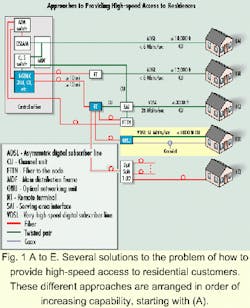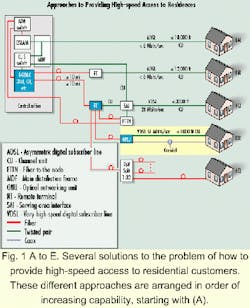Fiber re-emerges as a residential access architecture
As fiber penetrates deeper into the access network, fiber-to-the-curb often makes sense for cost-effective, full-service delivery to the neighborhood.
"Fiber-to-the..." doesn't command nearly the attention that it did several years ago. Whether the fourth letter was "N" for node, "C" for curb, or "H" for home, the concept of deploying fiber into residential service areas lost much of its luster because the promised technology got ahead of available services and economics.
Services today, however, justify deployment of fiber as a residential access architecture. Technology improvements and revolutionary changes that affect economic factors have rehabilitated the "fiber-to-the..." movement among local-exchange carriers. Economics still remains the deciding factor, however, in how deep fiber penetrates in the access networks that serve residential areas.
The biggest change from five years ago is the nature of the services demanded by residential customers. While "plain old telephone service" (POTS) requirements are greater than ever, demand for high-speed Internet access is increasing exponentially, with no end in sight to the demand for services and for higher bandwidth. There is also the possibility of carrying broadcast TV, along with other forms of video, on the same fiber that supports high-speed network access and basic telephone service.
Other changes involve the electronics associated with pushing fiber deeper into the network. New miniaturized components are cheaper, require less power, and are inherently more reliable. In general, the reliability of electronics,already good, has improved even more. And what once was a cabinet full of equipment is now a simple, unobtrusive pedestal at the curbside. The result of these changes is simplified installation and reduced life-cycle costs.
All these changes have contributed to a resurgence of interest in fiber-to-the-curb (FTTC). Based on Asynchronous Transfer Mode (ATM) at the OC-3 rate (155 Mbits/sec)--easily upgradable to OC-12 (622 Mbits/sec)--this FTTC approach offers the flexibility to carry a wide variety of services, including those that are Internet protocol (IP)-based. Under the right circumstances, FTTC may well represent the most cost-effective termination point for fiber in the residential plant.
Since service providers face an array of circumstances, it isn't possible to specify a single point where fiber should always be run. A carrier facing a "greenfield" development may very well decide to run fiber to each home. Where there is a great deal of existing copper plant, the question may be whether to refurbish it or to deploy fiber. If next-generation digital-loop carrier (NGDLC) is already deployed, then building on that base is probably the most economical approach.Perhaps the simplest approach is to use existing copper to carry asymmetric digital subscriber line (ADSL) directly to the subscriber (see Fig. 1A). Even when the copper plant is in good condition, however, ADSL service is limited to 18,000 ft from the central office (CO), and data speeds top out at about 6 Mbits/sec downstream and considerably less upstream. This approach is most attractive in areas fully served by existing copper plant.
Essentially, the same technique can be used where fiber-based NGDLC provides fiber to the remote terminal (RT). Here, the ADSL on copper begins at the RT, which may be 10 mi or more from the CO and typically extends as much as another 12,000 ft to the subscriber (see Fig. 1B).
Other access solutions depend on the copper distribution from the serving-area interface (SAI). The SAI, sometimes called a copper crossconnect, is part of a node that can be connected to the CO by either copper or fiber (see Fig. 1C). Fiber connection to the CO is normally via the RT, in which case both narrowband and broadband services are delivered. But if the node can separate ATM traffic from other types of narrowband NGDLC traffic, there may be a direct fiber connection to an ATM switch in the CO. This approach to ATM separation is an overlay strategy to supplement existing equipment.
In either case, a variety of distribution techniques can be used on the copper from the SAI to the subscriber. These techniques can include, for example, ADSL, very-high-speed DSL (VDSL), or 10Base-T Ethernet. Figure 1C shows VDSL with a downstream bit rate of 26 Mbits/sec (and an upstream rate of 3 Mbits/sec). The distance limitation of VDSL at this rate is 3000 ft, while 10Base-T is limited to 500 ft. Different data rates apply for various distances. The Table shows standard VDSL downstream and upstream bit rates with the corresponding distance limitations on copper.
Fiber-to-the-home (FTTH) is often assumed to be the ultimate bandwidth-delivering mechanism. Figure 1E shows an FTTH architecture connected by fiber to the RT; the fiber also can link directly to the CO. The all-optical network shown uses an optical splitter to serve up to 32 subscribers. The number of subscribers is limited in part by the specific algorithm used in the control circuitry and by the transmission loss budget. An alternative arrangement could use cascaded splitters--as long as the total number of subscribers isn't more than 32. Either way, the 32-way split creates an optical loss budget of 25 dB. Overcoming this loss requires a more powerful (and, therefore, somewhat more expensive) laser transmitter than one used in an unsplit transmission path.
The benefit to the subscriber is essentially unlimited bandwidth--both downstream and upstream. For example, Alcatel's ATM-over-passive-optical-network (APON) system now provides symmetrical OC-3 service. Plans call for OC-12 service when demand justifies that rate, accompanied by a future 1:64 split ratio.
The all-optical network is attractive today to small-business users that demand multiple T1 (1.554-Mbit/sec) rates and native local-area-network connectivity. For the residential market, an all-optical network delivers far more bandwidth than most subscribers need, and it requires a locally powered network interface device (NID) at the home. The NID sorts out the services delivered over a single fiber, such as high-speed network access, broadcast TV, and POTS. This sorting requires not only local power, but also some form of battery backup to support emergency telephone service in case of a power failure.
The NIDs used in FTTH are expensive to build. Enough demand could develop, however, to lower the costs. Even so, FTTH is still likely to find its major applications in greenfield developments. The cost of putting new fiber into older areas served by buried plant, which often involves extensive hand labor--and possibly digging up someone's prize petunias--is likely to remain high. Aerial cable replacement with fiber is viewed as an economical alternative. It is the most common existing construction, by far, for the majority of U.S. customers.
The FTTC architecture offers nearly the same bandwidth as the FTTH solution without requiring the locally powered NID at the subscriber's premises (see Fig. 1D). Each optical-network unit (ONU) serves eight to 12 homes within a radius of 1000 ft. Twisted pairs to the homes provide high-speed network access by several techniques. While this example shows VDSL at 51 Mbits/sec, other arrangements can also work. For instance, by using VDSL operating at 26 Mbits/sec, the distance from the ONU to the subscriber's premises can increase to 3000 ft. Some operators even offer a native 10Base-T Ethernet service to subscribers within 500 ft of the ONU.While not required for network access, the coaxial cable from the ONU to the home carries a "bonus" of this FTTC approach--cable-like broadcast TV. This capability requires only an extra wavelength on the fiber. If data and telephony are carried at 1310 nm, for example, broadcast TV is carried at 1550 nm. The number of broadcast channels depends on the TV baseband.
Assuming the 1-GHz baseband now used by many cable companies, a typical channel mix is 110 analog and 40 digital, with two-way service supported on the ATM feed from the ONU.
Methods of implementing FTTC may differ slightly. However, the arrangement described here, based on Alcatel's Litespan NGDLC access platform, illustrates the concept.
Key to the economics of this FTTC approach is its ability to deliver current and future services on an as-needed basis. For example, this architecture is an attractive way to deliver a transparent mix of broadcast and Web-based interactive TV. Using appropriate set-top units, subscribers can simply point a remote control at the TV without considering whether the picture is delivered by analog or digital broadcast TV or by IP over the Internet. The revenue-generating potential of such a service is difficult to overestimate.
While FTTC can deliver such bandwidth-intensive services, it also can serve anyone in the neighborhood who needs only POTS. Since no electronics are located on the subscriber's premises, only the existing twisted-pair copper (without the VDSL) is required for POTS. For those subscribing to high-speed Internet services, the operator can add the appropriate xDSL interface at the ONU, while subscribers requiring video can be selectively fed with coax for the final 500 ft.
This FTTC approach is also futureproof in two ways. The OC-3 transmission rate to the ONU provides plenty of bandwidth for any services available today or contemplated in the near future. Video is carried on a separate wavelength from POTS and the Internet, and an upgrade to OC-12 (or even higher, if demand should warrant it) would involve only an interface-card change. Although it is difficult to imagine the necessity, wavelength-division multiplexing could increase the high-speed data capacity of the fiber, almost without limit.
Another option for the future is to evolve FTTC into FTTH. Simply replacing the ONU with an optical splitter, running the last few feet of fiber, and placing an NID at the subscriber's premises changes the topology.
The advantage of FTTC is flexibility-in the delivery of multiple services, time-to-market for new services, and topology. Any transmission plan naturally must consider the mix of services (and types of traffic) to be carried-not only today's applications, but also the as-yet-unknown services that will surely arise tomorrow. FTTC is a residential access architecture with the flexibility to carry new services as they become available. Regardless of how attractive the service may be, in-place infrastructure to carry it, versus building something new, can make a difference between success and failure.
Robert M. Keating is senior product line manager for Alcatel USA's Wireline Access Products Division (Petaluma, CA).


